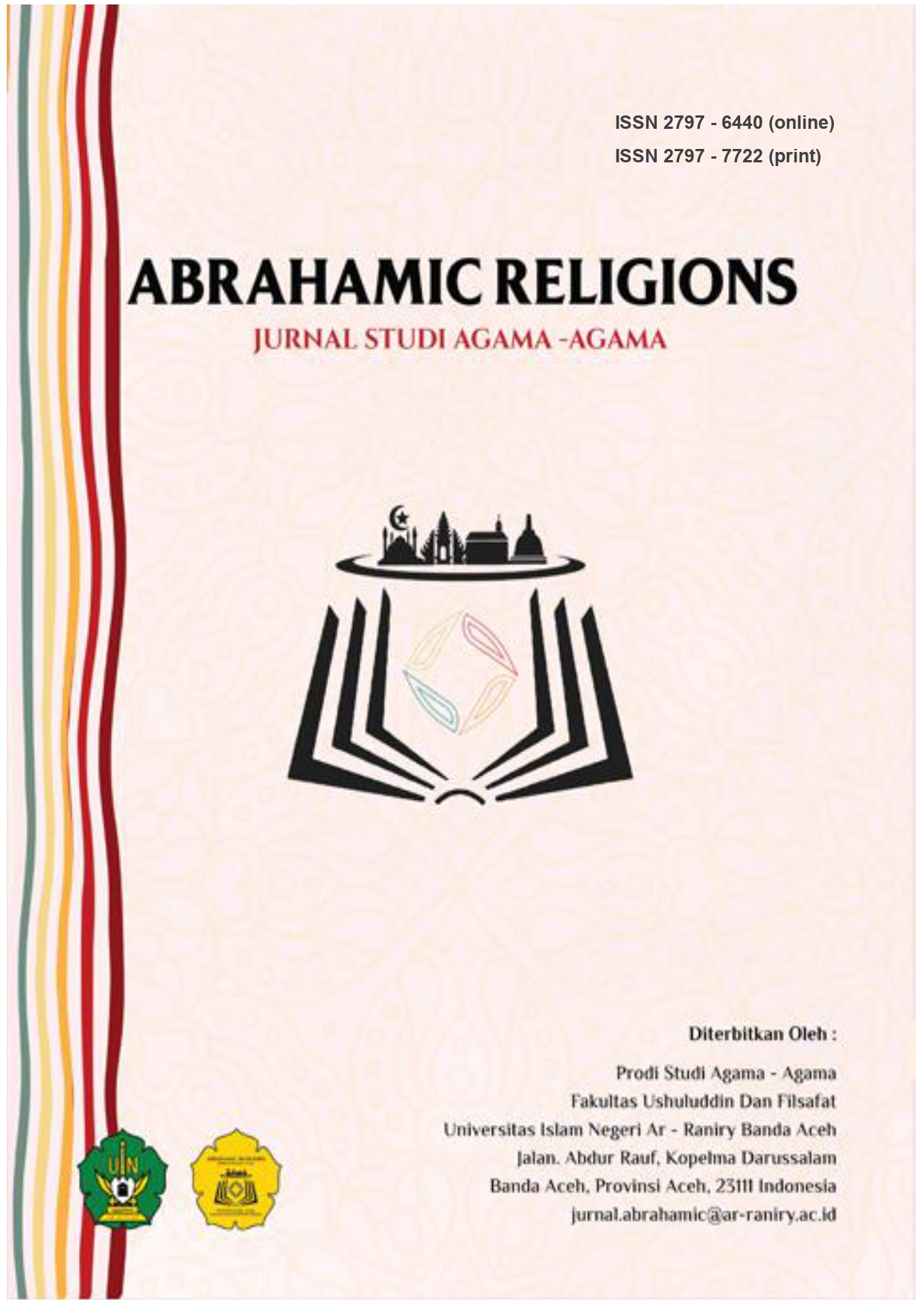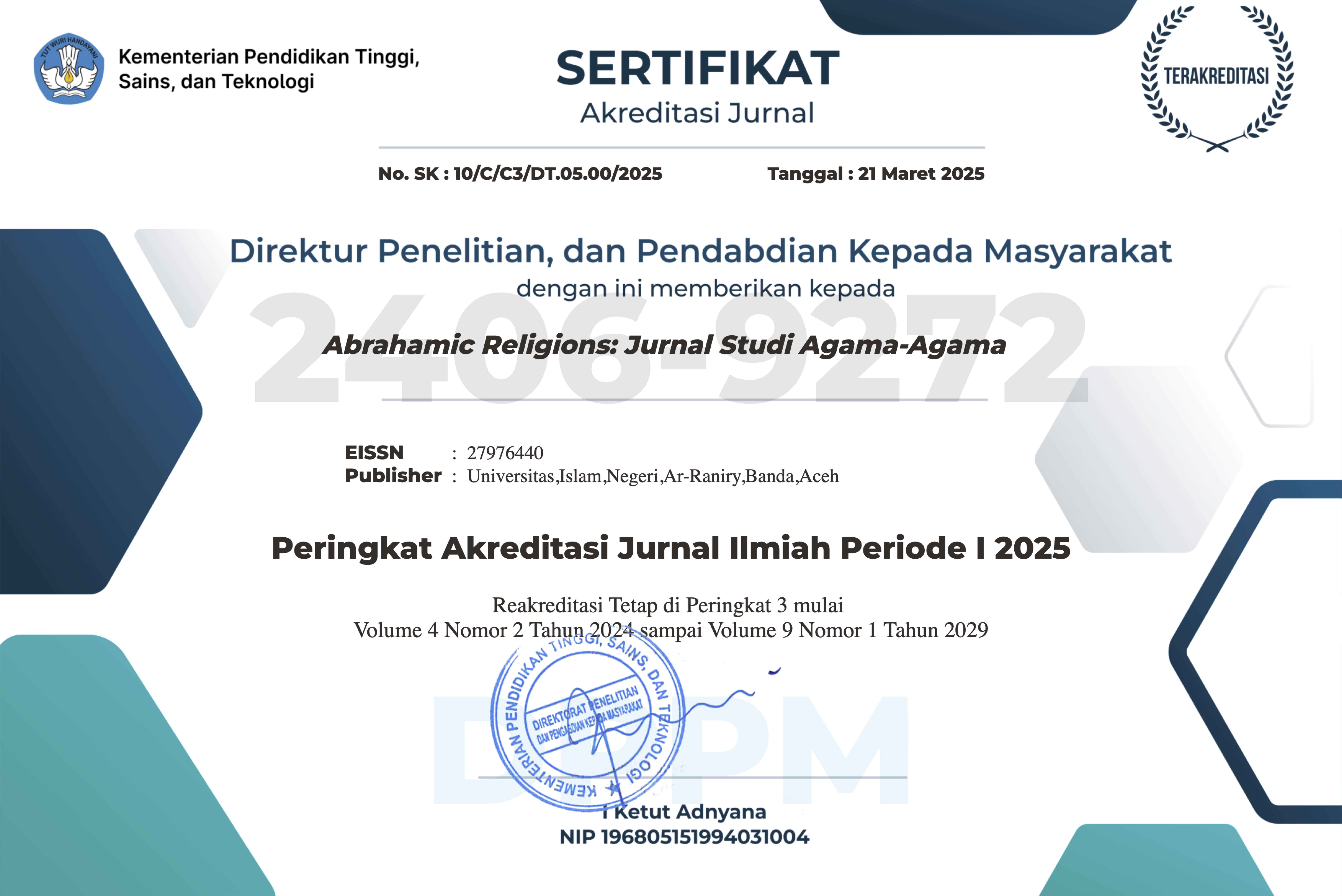GAYA HIDUP MINIMALIS SEBAGAI PENGAMALAN ILMU ESKATOLOGI DALAM MENGINGAT HARI AKHIR DAN AKHIRAT
DOI:
https://doi.org/10.22373/arj.v2i2.13402Keywords:
Eskatologi, Islam, Hari Akhir dan Akhirat, Gaya Hidup minimalis.Abstract
Eschatology is part of theology that discusses the last days, in Islamic teachings eschatology is closely related to the faith of a Muslim in the last days. And for a Muslim faith must be in line with the existence of evidence in the form of practice in everyday life that reflects an eschatology or faith in the last days. The practice of a science is very important because it will provide many benefits and significant developments for human life. Actually, there are many ways to practice and imply faith in the hereafter and eschatology, one of which is living a minimalist life. Then how can a minimalist life be said to be a practice of eschatology in remembering the last days or the afterlife. In this article, we will discuss this matter using qualitative research methods, in the form of literature review and literature study. The results of this study show that minimalist living can be used as the practice of eschatology in remembering the afterlife, because minimalist life is basically similar to qanaah and zuhud life, both of which focus on the afterlife. It also turns out that a minimalist life has been recommended from the beginning in Islamic teachings, namely living as simply as possible and not exaggerating in pursuing the world, and increasing practices to improve the quality of the afterlife.
Abstrak
Ilmu eskatologi merupakan bagian dari ilmu teologi yang membahas mengenai hari akhir, pada ajaran Islam ilmu eskatologi erat kaitannya dengan keimanan seorang muslim kepada hari akhir. Dan bagi seorang muslim keimanan itu harus sejalan dengan adanya pembuktian berupa pengamalan dalam kehidupan sehari-hari yang mencerminkan suatu ilmu eskatologi atau keimanan pada hari akhir. Pengamalan suatu ilmu sangat penting karena akan memberi manfaat yang banyak dan perkembangan yang signifikan bagi kehidupan manusia. Sebenarnya banyak cara dalam mengamalkan dan mengimplikasikan iman kepada hari akhir dan ilmu eskatologi, salah satu diantaranya adalah hidup minimalis. Lalu bagaimana bisa hidup minimalis dikatakan sebagai sebuah pengamalan ilmu eskatologi dalam mengingat hari akhir ataupun alam akhirat. Pada artikel ini akan dibahas mengenai hal tersebut dengan menggunakan metode penelitian kualitatif, berupa kajian pustaka dan studi literatur. Hasil dari penelitian ini ternyata hidup minimalis bisa digunakan sebagai pengamalan ilmu eskatologi dalam mengingat akhirat, karena hidup minimalis pada dasarnya mirip dengan qanaah dan hidup zuhud, dimana sama-sama memfokuskan diri untuk kehidupan akhirat. Juga ternyata hidup minimalis memang sudah dianjurkan dari dahulu pada ajaran islam, yaitu hidup sesederhana mungkin dan tidak berlebih-lebihan dalam mengejar dunia, serta memperbanyak amalan untuk meningkatkan kualitas kehidupan akhirat.
References
ALAIYAH, N. (2021). KONSEP HIDUP MINIMALIS DALAM PERSPEKTIF AL-QUR’AN. UNIVERSITAS ISLAM NEGERI AR-RANIRY DARUSSALAM - BANDA ACEH.
Ananda. (2022). Minimalism: Gaya Hidup Minimalis yang Lekat dengan Anak Muda.
Farida Utami Ritongga. (2022). Siapa Minimalis Sejati? Baktinusa.Id.
Frisca, F. (2020). Tips Hidup Minimalis di Masa Pandemi ala Komunitas Lyfe With Less. Fimela.
Hadiyanto, A., & Khumairoh, U. (2018). Makna Simbolik Ayat-Ayat tentang Kiamat dan Kebangkitan dalam Al-Qur’an. Hayula: Indonesian Journal of Multidisciplinary Islamic Studies, 2(2), 187–212. https://doi.org/10.21009/hayula.002.2.06
Hamidah. (2019). Implementasi Pemahaman Rukun Iman Dalam Pembentukan Akhlak Siswa Di Sma N 1 Kibang Lampung Timur. In Skripsi. INSTITUT AGAMA ISLAM NEGERI (IAIN) METRO.
Hanif, M. (n.d.). MINIMALISME DALAM ISLAM. Suara Mahasiswa.
Ibnu. (2022). Gaya Hidup Minimalis Adalah Tren Terkini Kaum Milenial. Accurate.
Lianovanda, D. (2021). gaya-hidup-minimalis @ blog.skillacademy.com. Skill Academy.
Millati, H. (2021). Tuntunan Hidup Minimalis dalam Al-Quran. Tafsiralquran.Id.
Muhammad, M., & Nurlaila, N. (2021). ARUS TOP-DOWN DAN BOTTOM-UP PADA GERAKAN DIALOG ANTAR AGAMA DI INDONESIA. Abrahamic Religions: Jurnal Studi Agama-Agama, 1(2), 159. https://doi.org/10.22373/arj.v1i2.10659
Norhidayat. (n.d.). ESKATOLOGI DALAM PERSPEKTIF ISLAM.
Novi Setyowati, Kusumah, N. I., Partini, Lestari, P. P., Umi, Amanah, Sudardi, B., & Hidayat, dan R. A. (2017). ESKATOLOGI ISLAM DALAM SYAIR IBARAT DAN KHABAR KIAMAT. Jurnal SMaRT, 03, 219–230.
Nurwahidin, N. (2009). Memaknai Kembali Eskatologi Dan Semangat Etos Kerja Islami. Humanika, 9(1), 13–24. https://doi.org/10.21831/hum.v9i1.3780
Putri, D. E. (2020). REPRESENTASI BUDAYA KONSUMENDI KOMUNITAS MINIMALIS LYFE WITH LESS. JURNAL ILMIAH DINAMIKA SOSIAL, 4(1), 270–276.
Suja’i, A. (2005). ESKATOLOGI : SUATU PERBANDINGAN ANTARA AL-GAZÂLÎ DAN IBN RUSYD Oleh : Ahmad Suja ’ i UNIVERSITAS ISLAM NEGERI SYARIF HIDAYATULLAH FAKULTAS USHULUDDIN DAN FILSAFAT Jakarta 2005 M / 1426 H. UIN Syarif Hidayatullah Jakarta.
Tualeka, M. W. N. (2016). pdf @ journal.um-surabaya.ac.id. AL-Hikmah: Jurnal Studi Agama-Agama, 2(1).
Ulya, F. N. (2019). Tren Belanja Milenial: Fashion, Diskon, hingga Gaya Hidup. Kompas.Com.
Downloads
Published
Issue
Section
License
Authors who publish in this Journal agree to the following terms:
- Authors retain copyright and grant the journal right of first publication with the work simultaneously licensed under Attribution-ShareAlike 4.0 International (CC BY-SA 4.0) allows others to share the work with an acknowledgment of the work's authorship and initial publication in this journal.
- Authors are able to enter into separate, additional contractual arrangements for the non-exclusive distribution of the journal's published version of the work (e.g., post it to an institutional repository or publish it in a book), with an acknowledgment of its initial publication in this journal.
- Authors are permitted and encouraged to post their work online (e.g., in institutional repositories or on their website) prior to and during the submission process, as it can lead to productive exchanges, as well as earlier and greater citation of published work. (See The Effect of Open Acces)















